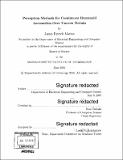| dc.contributor.advisor | Russ Tedrake. | en_US |
| dc.contributor.author | Marion, James Patrick | en_US |
| dc.contributor.other | Massachusetts Institute of Technology. Department of Electrical Engineering and Computer Science. | en_US |
| dc.date.accessioned | 2016-12-22T16:28:38Z | |
| dc.date.available | 2016-12-22T16:28:38Z | |
| dc.date.copyright | 2016 | en_US |
| dc.date.issued | 2016 | en_US |
| dc.identifier.uri | http://hdl.handle.net/1721.1/106091 | |
| dc.description | Thesis: S.M., Massachusetts Institute of Technology, Department of Electrical Engineering and Computer Science, 2016. | en_US |
| dc.description | Cataloged from PDF version of thesis. | en_US |
| dc.description | Includes bibliographical references (pages 89-96). | en_US |
| dc.description.abstract | Mobile robots can safely operate in environments that pose risks to human health, such as disaster zones and planetary exploration. Robots in these environments may encounter uneven terrain like debris fields, staircases, and rock ledges that are impossible to traverse with wheels or tracks but are surmountable by legged humanoid platforms through careful selection of footholds. The DARPA Robotics Challenge demonstrated that today's field robots are capable of uneven terrain traversal but they moved slowly and only for short durations. The stretches of walking are separated by longer stationary periods consumed by LIDAR data acquisition and human operator decision making. With the goal of improving autonomy, speed, and reliability, this thesis research investigates new algorithms for continuous locomotion over uneven terrain through online terrain perception and continuous footstep re-planning. A new algorithm for planar segmentation of terrain features is presented, along with a novel approach that integrates stereo depth fusion for terrain perception and online footstep re-planning using mixed-integer quadratic optimization. The approach is implemented within a novel software framework called Director, and results are validated on hardware using the Atlas humanoid robot with autonomous laboratory experiments and semi-autonomous field experiments at the DARPA Robotics Challenge Finals. | en_US |
| dc.description.statementofresponsibility | by James Patrick Marion. | en_US |
| dc.format.extent | 96 pages | en_US |
| dc.language.iso | eng | en_US |
| dc.publisher | Massachusetts Institute of Technology | en_US |
| dc.rights | M.I.T. theses are protected by copyright. They may be viewed from this source for any purpose, but reproduction or distribution in any format is prohibited without written permission. See provided URL for inquiries about permission. | en_US |
| dc.rights.uri | http://dspace.mit.edu/handle/1721.1/7582 | en_US |
| dc.subject | Electrical Engineering and Computer Science. | en_US |
| dc.title | Perception methods for continuous humanoid locomotion over uneven terrain | en_US |
| dc.type | Thesis | en_US |
| dc.description.degree | S.M. | en_US |
| dc.contributor.department | Massachusetts Institute of Technology. Department of Electrical Engineering and Computer Science | |
| dc.identifier.oclc | 965382448 | en_US |
